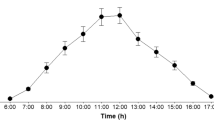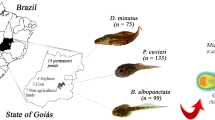Abstract
Background
Incidence of amphibian deformities have increased in recent years, especially in the northern region of the United States. While many factors have been proposed as being responsible for generating deformities (e.g., contaminants, ultraviolet radiation [UV], parasites), no single cause has been definitively established.
Methods
To determine whether waterborne chemicals are responsible for amphibian deformities in ponds in north-central Minnesota, we deployed semipermeable membrane devices (SPMDs) in an imparted and a reference site to accumulate lipophilic contaminants. We then exposed native tadpoles (northern leopard frogs;Rana pipiens) to the SPMD extracts combined with two agricultural pesticides (atrazine, carbaryl) at two levels of UV radiation.
Results and Discussion
UV radiation alone caused a slight increase in hatching success and tadpole growth rate. Deformity rate among hatchlings was high following exposure to SPMD extracts from the reference site in the absence of UV, suggesting that chemicals present at this site are broken down by UV to less harmful forms, or become less bioavailable. Conversely, impacted site SPMD extracts caused hatchling deformities only in the presence of UV, suggesting that UV potentiates the teratogenicity of the compounds present there. Impacted site SPMD extracts significantly increased the number of bony triangles among metamorphs, a common deformity observed at this site. The incidence of skin webbings increased significantly with SPMD extracts from both sites as well as with our pesticide control containing atrazine and carbaryl alone.
Conclusions
Higher deformity rates among tadpoles reared in the presence of UV radiation and SPMD extracts from sites where deformities are common indicates a chemical compound (or compounds) in the water at this site may be causing the deformities.
Recommendations and Oudook
It is important to examine the effects of chemical stressors in the presence of other natural stressors (e.g., UV radiation) to gain a better understanding of how multiple stressors work to impact amphibians and amphibian populations.
Similar content being viewed by others
References
Ankley GT, Tietge JE, Holcombe GW, DeFoe DL, Diamond SA, Jensen KM, Degitz SJ (2000): Effects of laboratory ultraviolet radiation and natural sunlight on survival and development ofRana pipiens. Canadian Journal of Zoology 78, 1092–1100
Applegate LA, Ley RD (1998): Ultraviolet radiation-induced lethality and repair of pyrimidine dimmers in fish embryos. Mutation Research 198, 85–92
Blaustein AR, Kiesecker JM, Olivers DP, Anthony RG (1997): Ambient UV-B radiation causes deformities in amphibian embryos. Proceedings of the National Academy of Sciences 94, 13735–13737
Blaustein AR, Kiesecker JM, Chivers DP, Hokit DG, Marco A, Belden LK, Hatch A (1998): Effects of ultraviolet radiation on amphibians: field experiments. American Zoologist 38, 799–812
Bonin J, Ouellet M, Rodrigue J, DesGranges J-L (1997): Measuring the health of frogs in agricultural habitats subjected to pesticides. Herpetological Conservation 1, 246–257
Bridges CM, Boone MD (2003): The interactive effects of UV-B and insecticide exposure on tadpoles survival, growth, and development. Biological Conservation 113, 49–54
Bridges CM, Semlitsch RD (2000): Variation in pesticide tolerance of tadpoles among and within species of ranidae and patterns of amphibian decline. Conservation Biology 14, 1490–1499 239
Broomhall SD, Osborne WS, Cunningham RB (2000): Comparative effects of ambient ultraviolet-B radiation on two sympatric species of Australian frogs. Conservation Biology 14, 420–427
Burkhart JG, Ankley G, Bell H, Carpenter H, Fort D, Gardiner D, Gardner H, Hale R, Helgen JC, Jepson P, Johnson D, Lannoo M, Lee D, Lary J, Levey R, Magner J, Meteyer C, Shelby MD, Lucier G (2000): Strategies for assessing the implications of malformed frogs for environmental health. Environmental Health Perspectives 108, 83–90
Burkhart JG, Helgen JC, Fort DJ, Gallagher D, Bowers D, Propst TL, Gernes M, Magner J, Shelby MD, Lucier G (1998): Induction of mortality and malformation inXenopus laevis embryos by water sources associated with frog deformities. Environmental Health Perspectives 106, 841–848
Canfield JT, Kersten SM, Vanselow P (2000): 1997–1999 Field Season Report, Minnesota Pollution Control Agency, Minneapolis, Minnesota, USA
Carman EN, Ferguson GW, Gehrmann WH, Chen TC, Holick MF (2000): Photobiosynthetic opportunity and ability for UV-B generated vitamin D synthesis in free-living house geckos (Hemi- dactylus turcicus) and Texas spiny lizards (Scleroporus olivaceous). Copeia 2000, 245–250
Crump D, Berrill M, Coulson D, Lean D, McGillivray L, Smith A (1999): Sensitivity of amphibian embryos, tadpoles, and larvae to enhanced UV-B radiation in natural pond conditions. Canadian Journal of Zoology 77, 1956–1966
Fort DJ, Rogers RL, Copley HF, Bruning, LA, Stover EL, Helgen JC, Burkhart JC (1999a): Progress toward identifying causes maldevelopment induced inXenopus by pond water and sediment extracts from Minnesota, USA. Environmental Toxicology and Chemistry 18, 2316–24
Fort DJ, Propst TL, Stover EL, Helgen JC, Levey RB, Gallagher K, Burkhart JC (1999b): Effects of pond water, sediment, and sediment extracts from Minnesota and Vermont, USA, on early development and metamorphosis ofXenopus. Environmental Toxicology and Chemistry 18, 2305–2315
Gardiner DM, Hoppe DM (1999): Environmentally induced limb malformations in mink frogs(Rana septentrionalis). Journal of Experimental Zoology 284, 207–216
Gosner KL (1960): A simplified table for staging anuran embryos and larvae with notes on identification. Herpetologica 16,183–190
Helgen JC, Gernes MC, Kersten SM, Chirhard JW, Canfield JT, Bowers D, Haferman J, McKinnell RG, Hoppe DM (2000): Field investigations of malformed frogs in Minnesota 1993-1997. Journal of the Iowa Academy of Sciences 107, 96–112
Hoppe DM (2000): History of Minnesota frog abnormalities: do recent findings represent a new phenomenon? Journal of the Iowa Academy of Sciences 107, 86–89
Huckins JN, Manuweera GK, Petty JD, Mackay D, Lebo JA (1993): Lipid-containing semipermeable membrane devices for monitoring organic contaminants in water. Environmental Science and Technology 27, 2489–2496
Huckins JN, Petty JD, Prest HF, Clark RC, Alvarez DA, Orazio CE, Lebo JA, Cranor WL, Johnson BT (2002): A Guide for the use of semipermeable membrane devices (SPMDs) as samplers of waterborne hydrophobic organic contaminants. Report prepared for the American Petroleum Institute (API), API no. 4690, 186 pp
Johnson PJT, Lunde KB, Ritchie EG, Launer AE (1999): The effect of trematode infection on amphibian limb development and survivorship. Science 284, 802–804
Lannoo MJ (2000): Conclusions drawn from the malformity and disease session, Midwest declining amphibians conference 1998. Journal of the Iowa Academy of Sciences 107, 212–216
Little EE, Calfee R, Cleveland L, Skinker R, Zaga-Parkhurst A, Barron MG (2000): Photo-enhanced toxicity in amphibians: synergistic interactions of solar ultraviolet radiation and aquatic contaminants. Journal of the Iowa Academy of Sciences 107, 67–771
Little EE, Fabacher DL (1996): Exposure of freshwater fish to simulated solar UVB radiation. In: Techniques in Aquatic Toxicology. Ostrander G (ed.). Lewis Publishers, New York, pp 141–158
Lizana M, Pedraza EM (1998): The effects of UV-B radiation on toad mortality in mountainous areas of central Spain. Conservation Biology 12, 703–707
Mackay D, Shiu W-Y, Ma K-C (1991): Illustrated Handbook of Physical-Chemical Properties and Environmental Fate for Organic Chemicals. Volume I. Lewis Publishers, Chelsea, Michigan, USA. 704 pp
Mackay D, Shiu W-Y, Ma, K-C (1992): Illustrated Handbook of Physical-Chemical Properties and Environmental Fate for Organic Chemicals. Volume II. Lewis Publishers, Chelsea, Michigan, USA. 608 pp
Mackay D, Shiu W-Y, Ma K-C (1997): Illustrated Handbook of Physical-Chemical Properties and Environmental Fate for Organic Chemicals. Volume V. Lewis Publishers, Chelsea, Michigan, USA. 832 pp
Merila J, Laurila A, Pahkala M (2000): Effects of ambient UV-B radiation on early development of the common frog(Rana temporaria) embryos in the subarctic. Annals Zoologica Fennici 37, 51–58
Meteyer CU (2000): Field guide to malformations of frogs and toads with radiographic interpretations. Biological Sciences Report USGS/BRD/BSR-2000–0005
Meteyer CU, Cole RA, Converse KA, Docherty DE, Wolcott M, Helgen JC, Levey R, Eaton-Poole L, Burkhart JG (2000): Defining anuran malformations in the context of a developmental problem. Journal of Iowa Academy of Sciences 107, 72–7800
Ouellet M (2000): Amphibian deformities: current state of knowledge. In: Ecotoxicology of Amphibians and Reptiles. Sparling DW, Linder G, Bishop CA (eds). SETAC Press, Pensacola, pp. 617–661
Ouellet M, Bonin J, Rodrigue J, DesGranges J-L, Lair S (1997): Hindlimb deformities (ectromelia, ectrodactyly) in free-living anurans from agricultural habitats. Journal of Wildlife Disease 33, 95–104
Pahkala M, Merila J, Ots I, Laurila A (2003) Effects of ultraviolet B radiation on metamorphic traits in the common frogRana temporaria. Journal of Zoology 259, 57–62
Petty JD, Orazio CE, Huckins JN, Gale RW, Lebo JA, Meadows JC, Echols KR, Cranor WL (2000): Considerations involved with the use of semipermeable membrane devices for monitoring environmental contaminants. Journal of Chromatography A 879, 83–95
Petty JD, Jones SB, Huckins JN, Cranor WL, Parris JT, McTague TB, Boyle TP (2000): An approach for assessment of water quality using semipermeable membrane devices (SPMDs) as bioindicator tests. Chemosphere 41, 311–321
SAS Institute, Inc (1998): SAS / STAT User’s Guide, Release 6.03 Edition, SAS Institute, Inc., Cary, NC, USA
Souder W (2000): A Plague of Frogs: the Horrifying True Story. Hyperion Press, New York. 320 pp
Starnes SM, Kennedy CA, Petranka JW (2000) Sensitivity of embryos of southern Appalachian amphibians to ambient solar UV B radiation. Conservation Biology 14, 277–282
Smith GR, Waters MA, Rettig JE (2000): Consequences of embryonic UV-B exposure for embryos and tadpoles of the plains leopard frog. Conservation Biology 14, 1903–1907
Wilbur HM, Collins JP (1973): Ecological aspects of amphibian metamorphosis. Science 182, 1305–1314
Zaga A, Little EE, Rabeni CF, Ellersieck MR (1998): Photoenhanced toxicity of a carbamate insecticide to early life stage anuran amphibians. Environmental Toxicology and Chemistry 17, 2543–2553
Author information
Authors and Affiliations
Corresponding author
Rights and permissions
About this article
Cite this article
Bridges, C., Little, E., Gardiner, D. et al. Assessing the toxicity and teratogenicity of pond water in north-central minnesota to amphibians. Environ Sci & Pollut Res 11, 233–239 (2004). https://doi.org/10.1007/BF02979631
Received:
Accepted:
Issue Date:
DOI: https://doi.org/10.1007/BF02979631




